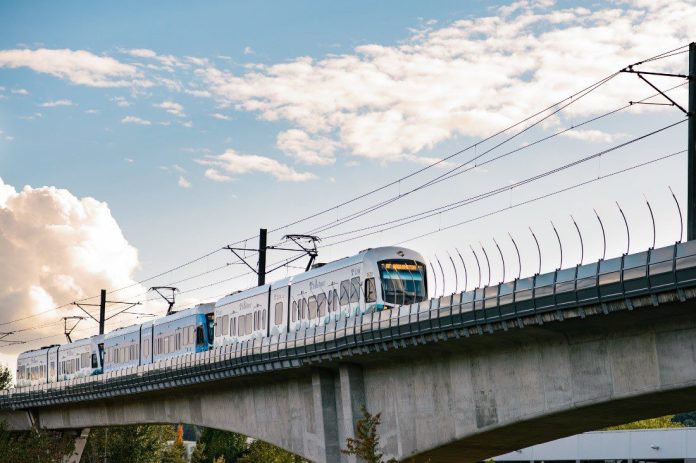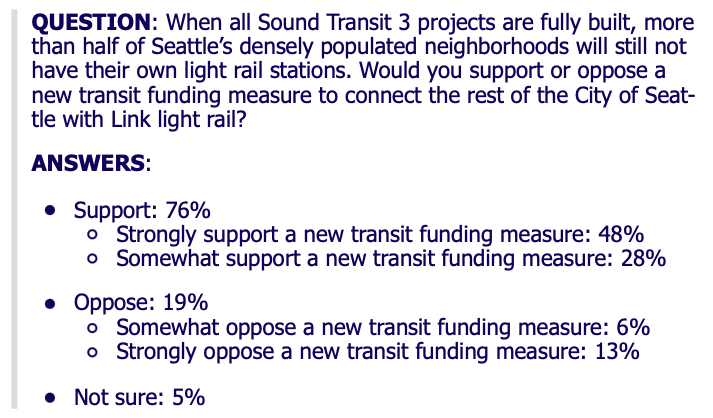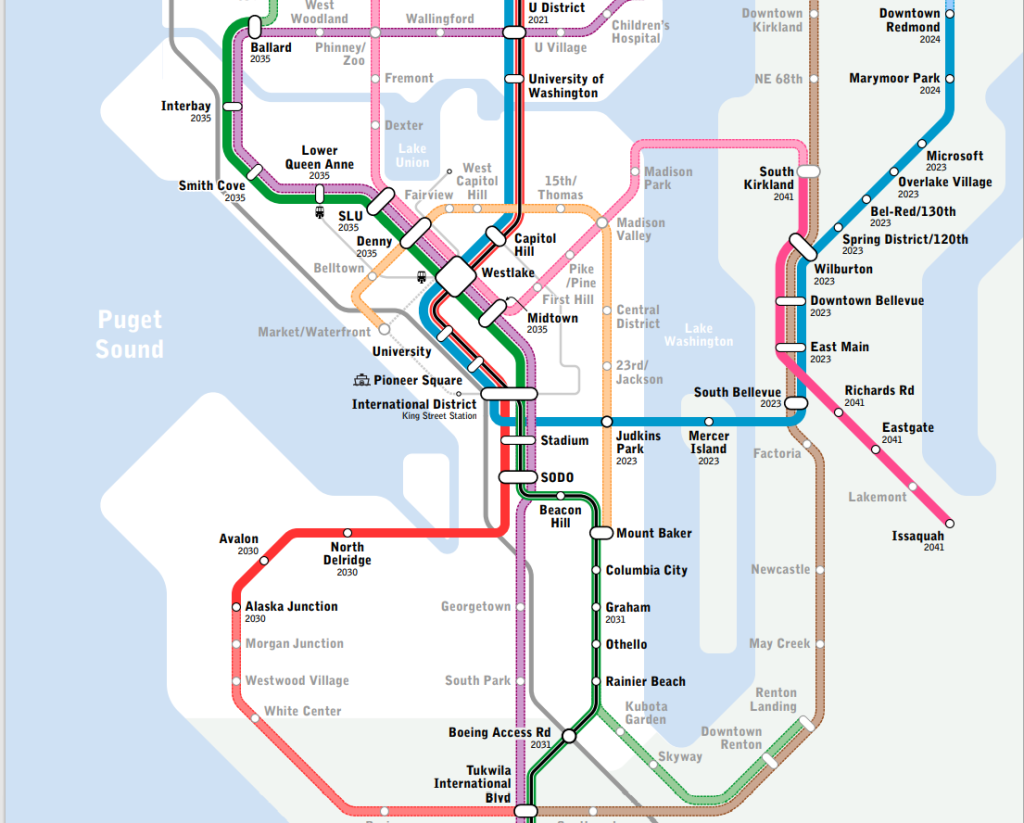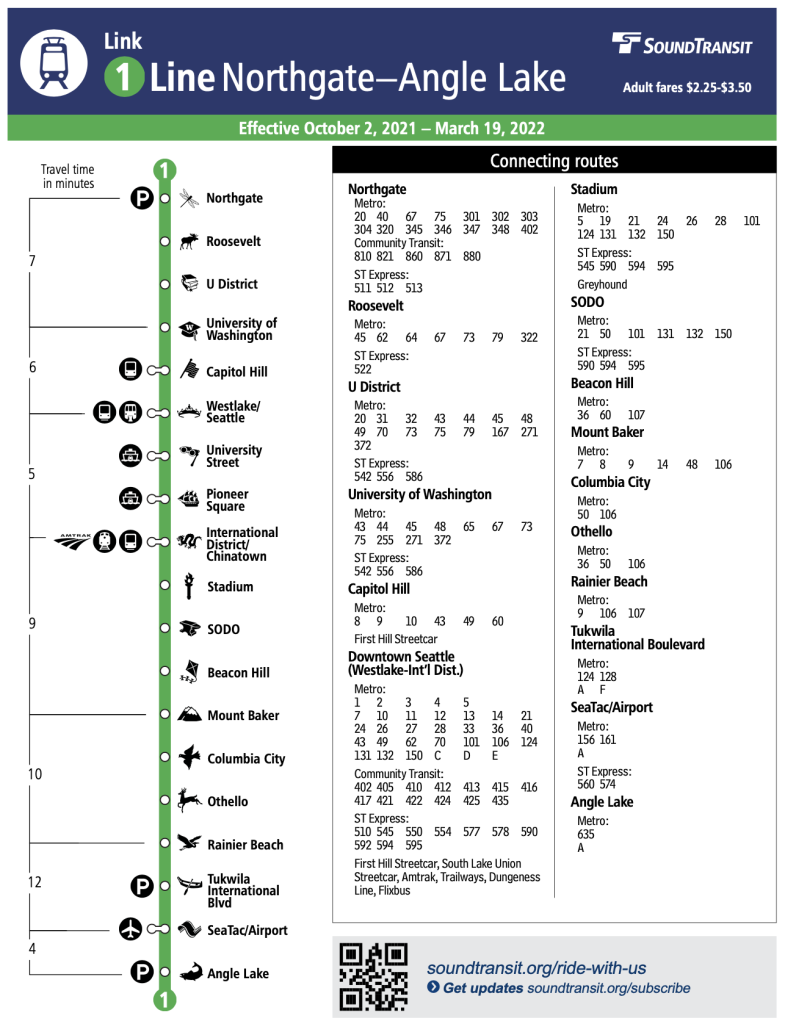
This summer in the lead up to decision-making on whether or not to delay projects promised in the Sound Transit 3 measure, the Northwest Progressive Institute (NPI) released results from a poll conducted by Change Research Institute. Their data showed 71% of polled Seattle voters expressed support for a new transit funding measure to avoid ST3 delays. Fortunately, the Sound Transit board voted for a hybrid realignment plan that avoids the most substantial delays, keeping promises made to area residents largely intact.
Now NPI has released data from a second question included in the poll, and it shows similar high levels of support for a new transit funding measure.
Pollees want more of Seattle connected to Link light rail
When asked if they would support or oppose a new transit funding measure to connect the rest of the City of Seattle with Link light rail, 76% of Seattle voters polled voiced support, with 48% expressing strong support.
The poll was conducted among 617 Seattle voters and has a modeled margin of error of 4.3% at the 95% confidence interval.
“We can’t afford to wait another quarter of a century to get Seattle’s other densely populated neighborhoods connected to Link,” said Andrew Villeneuve, NPI founder and executive director, in a press release. “Right now, we have just one high capacity transit line running through Seattle when we need several. Seattle Subway’s Vision Map shows us where we need to invest to ensure everyone in the Emerald City has access to high quality transit. While we work to accelerate delivery of ST3 projects, we should also be thinking about what comes after ST3, because we’re way behind getting multimodal transportation infrastructure built.”
The statement released alongside the poll by NPI acknowledges while voters appear to be “sold on light rail as a good investment, there is still the practical matter of delivering it to the neighborhoods that need it.” A major part of delivery will involve deciding how to finance new transit, an aspect of planning that is never easy.
A timely poll
Only weeks remain before Sound Transit’s Link light rail extension opens on October 2nd. On that day, thousands of Seattleites living near the 1 Line (formerly known as the Central Link) will gain access to fast, frequent transit running all the way from Northgate to Angle Lake. For people whose daily trips fall within the light rail service area, or who live near connecting bus routes, the introduction of the new stations will be a transportation game changer. Link light rail ridership doubled after the addition of the Capitol Hill and University of Washington Stations in 2016 and a similar surge in ridership is possible in 2021.
As exciting as the Link expansion is, the fact remains that most Seattle residents will largely maintain their current travel habits because light rail will be located too far from their homes and the places they need to travel. This is why transit advocates like NPI and Seattle Subway are pushing to expand the light rail network across Seattle, and the the poll suggests the Seattle electorate is onboard.
Questions remain about how to fund transit expansion
The poll did not present any idea of what the new transit funding measure would be. Thus, it is hard to conclude how respondents would have reacted if they felt costs would have fallen too heavily on their shoulders when funding mechanisms start getting specific rather than broad and amorphous. However, the poll’s strong showing of support for a new transit funding measure indicates a majority of Seattle voters are willing to pay more for transit expansion, a finding backed up by a history of voter support for measures such as the Move Seattle Levy, the previous Sound Transit expansion referendums, and the Seattle Transportation Benefit District renewal, which passed with 80% of the vote in 2020.
However, until now Sound Transit has sought regional funding for its projects. There are practical reasons behind this approach. For one thing, congestion and the need for increased transit are not restricted to Seattle alone, and a regional approach acknowledges these needs, while providing for a larger and more diverse tax payer base to finance multi-billion dollar transit investments.
There is also the matter of a state-level hurdle that stands in the way of Seattle raising its own funding for light rail. While Seattle can raise money for other citywide transportation improvements like roads, bridges, buses, streetcars, bike lanes, and sidewalks, the City has limited authority to raise funding for “grade separated transportation improvements” (i.e., rail, on its own).
Shaun Kuo reported for The Urbanist back in January how State Representative David Hackney (D-11th Legislative District) proposed House Bill 1304, which would have amended “the existing City Transportation Authority (CTA), which was intended for Seattle’s monorail expansion ambitions, to fund grade-separated rail transit instead.” Despite fellow Democratic Representatives Liz Berry (36th Legislative District), Joe Fitzgibbon (34th Legislative District), Frank Chopp (43rd Legislative District), Nicole Macri (43rd Legislative District), Steve Bergquist (11th Legislative District), and Gerry Pollet (46th Legislative District) all signing on as co-sponsors, and words of support from King County Executive Dow Constantine and Sound Transit State Relations Director Alex Soldano, the legislation did not make it out of its legislative committee this season. Backers hope that it will be back on the docket next year.
While opening the door to independent revenue generation for light rail in Seattle would expand future funding possibilities, it is also conceivable that a regional approach to transit funding would continue to succeed. 54% of voters in the Sound Transit Taxing District approved Sound Transit 3’s referendum in 2016. While Tim Eyman’s Initiative 976 ($30 car tabs), which would have dealt a huge blow to transit funding, passed statewide, it was rejected in the Sound Transit Taxing District. The Washington Supreme Court took note of this fact when it ruled I-976 was unconstitutional.
“The initiative passed statewide with about 53% of the vote, though it was rejected by about 53% of the voters in the Sound Transit region, about 60% of King County voters, and about 70% of San Juan voters, who depend heavily on ferries funded by motor vehicle excise taxes,” the court’s opinion stated.
If three quarters of Seattle voters were to turn out in favor of a Sound Transit 4 expansion funding measure, as the NPI poll indicates, the support would likely be enough to carry a regional or countywide measure forward.
Natalie Bicknell Argerious (she/her) is a reporter and podcast host at The Urbanist. She previously served as managing editor. A passionate urban explorer since childhood, she loves learning how to make cities more inclusive, vibrant, and environmentally resilient. You can often find her wandering around Seattle's Central District and Capitol Hill with her dogs and cat. Email her at natalie [at] theurbanist [dot] org.




